ajax向服务器发送数据需要哪些步骤
这次给大家带来ajax向服务器发送数据需要哪些步骤,ajax向服务器发送数据的注意事项有哪些,下面就是实战案例,一起来看一下。
1. 准备向服务器发送数据
Ajax 最常见的一大用途是向服务器发送数据。最典型的情况是从 客户端发送表单数据,即用户在form元素所含的各个 input 元素里输入的值。下面代码展示了一张简单的表单:
<!DOCTYPE html>
<html lang="en">
<head>
<meta charset="UTF-8">
<title>基本表单</title>
<style>
.table{display: table;}
.row{display: table-row;}
.cell{display: table-cell;padding: 5px;}
.lable{text-align: right;}
</style>
</head>
<body>
<form id="fruitform" method="post" action="http://127.0.0.1:8080/form">
<p class="lable">
<p class="row">
<p class="cell lable">Apples:</p>
<p class="cell"><input name="apples" value="5" /></p>
</p>
<p class="row">
<p class="cell lable">Bananas:</p>
<p class="cell"><input name="bananas" value="2" /></p>
</p>
<p class="row">
<p class="cell lable">Cherries:</p>
<p class="cell"><input name="cherries" value="20" /></p>
</p>
<p class="row">
<p class="cell lable">Total:</p>
<p id="results" class="cell">0 items</p>
</p>
</p>
<button id="submit" type="submit">Submit Form</button>
</form>
</body>
</html>这个例子中的表单包含三个input元素和一个提交button 。这些input元素让用户可以指定三种不同的说过各自要订购多少,button则会将表单提交给服务器。
1.1 定义服务器
显而易见,这里需要为这些示例创建处理请求的服务器。这里再一次使用Node.js,原因主要是它很简单,而且用的是Javascript。新建 fruitcalc.js脚本文件如下:
var http = require('http');
var querystring = require('querystring');
function writeResponse(res,data){
var total = 0;
for(fruit in data){
total += Number(data[fruit]);
}
res.writeHead(200,"OK",{
"Content-Type":"text/html",
"Access-Control-Allow-Origin":"http://localhost:63342"
});
res.write('<html><head><title>Fruit Total</title></head><body>');
res.write('<p>'+total+' item ordered</p></body></html>');
res.end();
}
http.createServer(function(req,res){
console.log("[200] "+req.method+" to "+req.url);
if(req.method == "OPTIONS"){
res.writeHead(200,"OK",{
"Access-Control-Allow-Header":"Content-Type",
"Access-Control-Allow-Methods":"*",
"Access-Control-Allow-Origin":"*"
});
res.end();
}else if(req.url == '/form'&& req.method == 'POST'){
var dataObj = new Object();
var contentType = req.headers["content-type"];
var fullBody = '';
if(contentType){
if(contentType.indexOf("application/x-www-form-urlencode") > -1){
req.on('data',function(chunk){
fullBody += chunk.toString();
});
req.on('end',function(){
var dBody = querystring.parse(fullBody);
dataObj.apples = dBody["apples"];
dataObj.bananas = dBody["bananas"];
dataObj.cherries = dBody["cherries"];
writeResponse(res,dataObj);
});
}else if(contentType.indexOf("application/json") > -1){
req.on('data',function(chunk){
fullBody += chunk.toString();
});
req.on('end',function(){
dataObj = JSON.parse(fullBody);
writeResponse(res,dataObj);
});
}
}
}
}).listen(8080);脚本中高亮部分:writeResponse函数。这个函数会在提取请求的表单值之后调用,它负责生产对浏览器的响应。当前,这个函数会创建简单的HTML文档,效果如下:
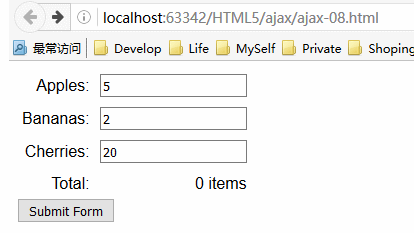
这个响应很简单,实现效果是让服务器计算出了用户通过form中各个input元素所订购的水果总数。服务器得端脚本的其余部分负责解码客户端用Ajax发送的各种可能数据格式。
1.2 理解问题所在
上面的图片清楚的描述了想要用Ajax解决的问题。
当提交表单后,浏览器会在新的页面显示结果。这意味着两点:
* 用户必须等待服务器处理数据并生成响应;
* 所有文档上下文信息都丢失了,因为结果是作为新文档进行显示的。
这就是应用Ajax的理想情形了。可以异步生成请求,这样用户就能在表单被处理时继续与文档进行交互。
2. 发送表单
向服务器发送数据的最基本方式是自己收集并格式化它。下面代码展示了添加到前面的HTML文档 example.html 的一段脚本。用的就是这种方式:
<!DOCTYPE html>
<html lang="en">
<head>
<meta charset="UTF-8">
<title>手动收集和发送数据</title>
<style>
.table{display: table;}
.row{display: table-row;}
.cell{display: table-cell;padding: 5px;}
.lable{text-align: right;}
</style>
</head>
<body>
<form id="fruitform" method="post" action="http://127.0.0.1:8080/form">
<p class="lable">
<p class="row">
<p class="cell lable">Apples:</p>
<p class="cell"><input name="apples" value="5" /></p>
</p>
<p class="row">
<p class="cell lable">Bananas:</p>
<p class="cell"><input name="bananas" value="2" /></p>
</p>
<p class="row">
<p class="cell lable">Cherries:</p>
<p class="cell"><input name="cherries" value="20" /></p>
</p>
<p class="row">
<p class="cell lable">Total:</p>
<p id="results" class="cell">0 items</p>
</p>
</p>
<button id="submit" type="submit">Submit Form</button>
</form>
<script>
document.getElementById("submit").onclick = handleButtonPress;
var httpRequest;
function handleButtonPress(e){
//对表单里的button元素而言,其默认行为是用常规的非Ajax方式提交表单。这里不想让他发生,所以调用了preventDefault方法
e.preventDefault();
var form = document.getElementById("fruitform");
//收集并格式化各个input的值
var formData ="";
var inputElements = document.getElementsByTagName("input");
for (var i = 0; i < inputElements.length; i++){
formData += inputElements[i].name + "=" + inputElements[i].value +"&";
}
httpRequest = new XMLHttpRequest();
httpRequest.onreadystatechange = handleResponse;
//数据必须通过POST方法发送给服务器,并读取了HTMLFormElement的action属性获得了请求需要发送的URL
httpRequest.open("POST",form.action);
//添加标头来告诉服务器准备接受的数据格式
httpRequest.setRequestHeader('Content-Type','application/x-www-form-urlencoded');
//把想要发送给服务器的字符串作为参数传递给send方法
httpRequest.send(formData);
}
function handleResponse(){
if(httpRequest.readyState == 4 && httpRequest.status == 200){
document.getElementById("results").innerHTML = httpRequest.responseText;
}
}
</script>
</body>
</html>效果图如下:
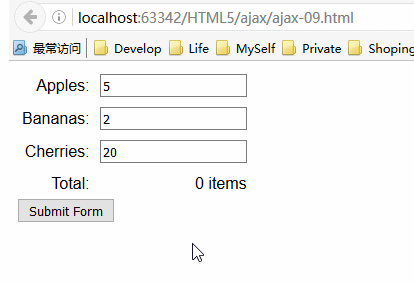
服务器响应表单提交后返回的HTML文档会显示在同一页,而且该请求是异步执行的。
3. 发送JSON数据
Ajax不止用来发送表单数据,几乎可以发送任何数据,包括JavaScript对象表示法(JavaScript Object Notation,JSON)数据,而它几乎已经成为一种流行的数据格式了。Ajax扎根于XML,但这一格式很繁琐。当运行的Web应用程序必须传输大量XML文档时,繁琐就意味着带宽和系统容量方面的实际成本。
JSON经常被称为XML的“脱脂”替代品。JSON易于阅读和编写,比XML更紧凑,而且已经获得了广泛支持。JSON发源于JavaScript,但它的发展已经超越了 JavaScript,被无数的程序包和系统理解并使用。
以下是一个简单的JavaScript对象用JSON表达的例子:
{"bananas":"2","apples":"5","cherries":"20"}这个对象有三个属性:bananas、apples和cherries。这些属性的值分别是2、5和20。
JSON的功能不如XML丰富,但对许多应用程序来说,那些功能是用不到的。JSON简单、轻量和富有表现力。下面例子演示了发送JSON数据到服务器有多简单,修改前例的JavaScript部分如下:
<script>
document.getElementById("submit").onclick = handleButtonPress;
var httpRequest;
function handleButtonPress(e){
e.preventDefault();
var form = document.getElementById("fruitform");
var formData = new Object();
var inputElements = document.getElementsByTagName("input");
for(var i=0;i<inputElements.length;i++){
formData[inputElements[i].name] = inputElements[i].value;
}
httpRequest = new XMLHttpRequest();
httpRequest.onreadystatechange = handleResponse;
httpRequest.open("POST",form.action);
httpRequest.setRequestHeader("Content-Type","application/json");
httpRequest.send(JSON.stringify(formData));
}
function handleResponse(){
if(httpRequest.readyState == 4 && httpRequest.status == 200){
document.getElementById("results").innerHTML = httpRequest.responseText;
}
}
</script>这段脚本,创建了一个新的Object,并定义了一些属性来对应表单内各个input元素的name属性值。可以使用任何数据,但 input元素很方便,而且能和之前的例子保持一致。
为了告诉服务器正在发送JSON数据,把请求的Content-Type标头设为 application/json,就像这样:
httpRequest.setRequestHeader("Content-Type","application/json");
用JSON对象和JSON格式进行相互的转换。(大多数浏览器能直接支持这个对象,但也可以用下面的网址里的脚本来给旧版的浏览器添加同样的功能:https://github.com/douglascrockford/JSON-js/blob/master/json2.js )JSON对象提供了两个方法:

在上面的例子中,使用了stringify方法,然后把结果传递给XMLHttpRequest 对象的send方法。此例中只有数据的编码方式发生了变化。提交表单的效果还是一样。
4. 使用FormData对象发送表单数据
另一种更简洁的表单收集方式是使用一个FormData对象,它是在XMLHttpRequest的第二级规范中定义的。
由于原来的Node.js代码有点问题,此处用C#新建文件 fruitcalc.aspx作为处理请求的服务器。其cs代码如下:
using System;
namespace Web4Luka.Web.ajax.html5
{
public partial class fruitcalc : System.Web.UI.Page
{
protected void Page_Load(object sender, EventArgs e)
{
int total = 0;
if (Request.HttpMethod == "POST")
{
if (Request.ContentType.IndexOf("multipart/form-data") > -1)
{
for (int i = 0; i < Request.Form.Count; i++)
{
total += Int32.Parse(Request.Form[i]);
}
}
writeResponse(Response, total);
}
}
private void writeResponse(System.Web.HttpResponse Response, int total)
{
string strHtml;
Response.AddHeader("Access-Control-Allow-Origin", "http://localhost:63342");
strHtml = total + " item ordered";
Response.Write(strHtml);
}
}
}4.1 创建 FormData 对象
创建FormData对象时可以传递一个HTMLFormElement对象,这样表单里所有的元素的值都会被自动收集起来。示例如下:
<!DOCTYPE html>
<html lang="en">
<head>
<meta charset="UTF-8">
<title>使用FormData对象</title>
<style>
.row{display: table-row;}
.cell{display: table-cell;padding: 5px;}
.lable{text-align: right;}
</style>
</head>
<body>
<form id="fruitform" method="post" action="http://localhost:53396/ajax/html5/fruitcalc.aspx">
<p class="lable">
<p class="row">
<p class="cell lable">Apples:</p>
<p class="cell"><input name="apples" value="5" /></p>
</p>
<p class="row">
<p class="cell lable">Bananas:</p>
<p class="cell"><input name="bananas" value="2" /></p>
</p>
<p class="row">
<p class="cell lable">Cherries:</p>
<p class="cell"><input name="cherries" value="20" /></p>
</p>
<p class="row">
<p class="cell lable">Total:</p>
<p id="results" class="cell">0 items</p>
</p>
</p>
<button id="submit" type="submit">Submit Form</button>
</form>
<script>
document.getElementById("submit").onclick = handleButtonPress;
var httpRequest;
function handleButtonPress(e){
e.preventDefault();
var form = document.getElementById("fruitform");
var formData = new FormData(form);
httpRequest = new XMLHttpRequest();
httpRequest.onreadystatechange = handleResponse;
httpRequest.open("POST",form.action);
httpRequest.send(formData);
}
function handleResponse(){
if(httpRequest.readyState == 4 && httpRequest.status == 200){
document.getElementById("results").innerHTML = httpRequest.responseText;
}
}
</script>
</body>
</html>当然,关键的变化是使用了FormData对象:
var formData = new FormData(form);
其他需要注意的地方是不再设置Content-Type标头的值了。如果使用FormData对象,数据总是会被编码为multipart/form-data 。本例提交表单后,显示效果如下:
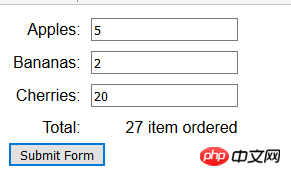
4.2 修改FormData对象
FormData对象定义了一个方法,它允许给要发送到服务器的数据添加名称/值对。

可以用append方法增补从表单中收集的数据,也可以在不使用HTMLFormElement的情况下创建FormData对象。这就意味着可以使用append方法来选择向客户端发送哪些数据值。修改上一示例的JavaScript代码如下:
<script>
document.getElementById("submit").onclick = handleButtonPress;
var httpRequest;
function handleButtonPress(e){
e.preventDefault();
var form = document.getElementById("fruitform");
var formData = new FormData();
var inputElements = document.getElementsByTagName("input");
for(var i=0;i<inputElements.length;i++){
if(inputElements[i].name != "cherries"){
formData.append(inputElements[i].name,inputElements[i].value);
}
}
httpRequest = new XMLHttpRequest();
httpRequest.onreadystatechange = handleResponse;
httpRequest.open("POST",form.action);
httpRequest.send(formData);
}
function handleResponse(){
if(httpRequest.readyState == 4 && httpRequest.status == 200){
document.getElementById("results").innerHTML = httpRequest.responseText;
}
}
</script>此段脚本里,创建FormData对象时并没有提供HTMLFormElement对象。随后用DOM找到文档里所有的input元素,并为那些name属性的值不是cherries的元素添加名称/值对。此例提交表单后,显示效果如下:
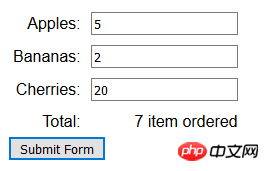
5. 发送文件
可以使用FormData 对象和type 属性为 file 的input 元素向服务器发送文件。当表单提交时,FormData对象会自动确保用户选择的文件内容与其他的表单值一同上传。下面的例子展示了如何以这种方式使用FormData对象。
<!DOCTYPE html>
<html lang="en">
<head>
<meta charset="UTF-8">
<title>使用FormData对象发送文件到服务器</title>
<style>
.row{display: table-row;}
.cell{display: table-cell;padding: 5px;}
.lable{text-align: right;}
</style>
</head>
<body>
<form id="fruitform" method="post" action="http://localhost:53396/ajax/html5/fruitcalc.aspx">
<p class="lable">
<p class="row">
<p class="cell lable">Apples:</p>
<p class="cell"><input name="apples" value="5" /></p>
</p>
<p class="row">
<p class="cell lable">Bananas:</p>
<p class="cell"><input name="bananas" value="2" /></p>
</p>
<p class="row">
<p class="cell lable">Cherries:</p>
<p class="cell"><input name="cherries" value="20" /></p>
</p>
<p class="row">
<p class="cell lable">File:</p>
<p class="cell"><input type="file" name="file" /></p>
</p>
<p class="row">
<p class="cell lable">Total:</p>
<p id="results" class="cell">0 items</p>
</p>
</p>
<button id="submit" type="submit">Submit Form</button>
</form>
<script>
document.getElementById("submit").onclick = handleButtonPress;
var httpRequest;
function handleButtonPress(e){
e.preventDefault();
var form = document.getElementById("fruitform");
var formData = new FormData(form);
httpRequest = new XMLHttpRequest();
httpRequest.onreadystatechange = handleResponse;
httpRequest.open("POST",form.action);
httpRequest.send(formData);
}
function handleResponse(){
if(httpRequest.readyState == 4 && httpRequest.status == 200){
document.getElementById("results").innerHTML = httpRequest.responseText;
}
}
</script>
</body>
</html>此例里,最明显的变化发生在 form元素上。添加了input元素后,FormData对象就会上传用户所选的任意文件。
修改 fruitcalc.aspx 的cs文件如下:
using System;
using System.Web;
namespace Web4Luka.Web.ajax.html5
{
public partial class fruitcalc : System.Web.UI.Page
{
protected void Page_Load(object sender, EventArgs e)
{
int total = 0;
if (Request.HttpMethod == "POST")
{
if (Request.ContentType.IndexOf("multipart/form-data") > -1)
{
for (int i = 0; i < Request.Form.Count; i++)
{
total += Int32.Parse(Request.Form[i]);
}
if (Request.Files["file"] != null)
{
HttpPostedFile file = Request.Files["file"];
file.SaveAs(Server.MapPath("/upload/pictures/" + file.FileName));
}
}
writeResponse(Response, total);
}
}
private void writeResponse(System.Web.HttpResponse Response, int total)
{
string strHtml;
Response.AddHeader("Access-Control-Allow-Origin", "http://localhost:63342");
strHtml = total + " item ordered";
Response.Write(strHtml);
}
}
}此例的显示效果如下:
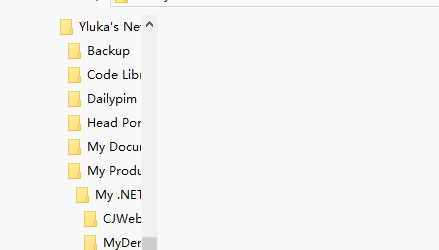
相信看了本文案例你已经掌握了方法,更多精彩请关注php中文网其它相关文章!
推荐阅读:
以上是ajax向服务器发送数据需要哪些步骤的详细内容。更多信息请关注PHP中文网其他相关文章!

热AI工具

Undresser.AI Undress
人工智能驱动的应用程序,用于创建逼真的裸体照片

AI Clothes Remover
用于从照片中去除衣服的在线人工智能工具。

Undress AI Tool
免费脱衣服图片

Clothoff.io
AI脱衣机

AI Hentai Generator
免费生成ai无尽的。

热门文章

热工具

记事本++7.3.1
好用且免费的代码编辑器

SublimeText3汉化版
中文版,非常好用

禅工作室 13.0.1
功能强大的PHP集成开发环境

Dreamweaver CS6
视觉化网页开发工具

SublimeText3 Mac版
神级代码编辑软件(SublimeText3)

热门话题
 无法连接到RPC服务器导致无法进入桌面的解决方法
Feb 18, 2024 am 10:34 AM
无法连接到RPC服务器导致无法进入桌面的解决方法
Feb 18, 2024 am 10:34 AM
RPC服务器不可用进不了桌面怎么办近年来,计算机和互联网已经深入到我们的生活中的各个角落。作为一种集中计算和资源共享的技术,远程过程调用(RPC)在网络通信中起着至关重要的作用。然而,有时我们可能会遇到RPC服务器不可用的情况,导致无法进入桌面。本文将介绍一些可能导致此问题的原因,并提供解决方案。首先,我们需要了解RPC服务器不可用的原因。RPC服务器是一种
 CentOS安装fuse及CentOS安装服务器详解
Feb 13, 2024 pm 08:40 PM
CentOS安装fuse及CentOS安装服务器详解
Feb 13, 2024 pm 08:40 PM
作为一名LINUX用户,我们经常需要在CentOS上安装各种软件和服务器,本文将详细介绍如何在CentOS上安装fuse和搭建服务器的过程,帮助您顺利完成相关操作。CentOS安装fuseFuse是一个用户空间文件系统框架,允许非特权用户通过自定义文件系统实现对文件系统的访问和操作,在CentOS上安装fuse非常简单,只需按照以下步骤操作:1.打开终端,以root用户登录。2.使用以下命令安装fuse软件包:```yuminstallfuse3.确认安装过程中的提示,输入`y`继续。4.安装完
 如何将Dnsmasq配置为DHCP中继服务器
Mar 21, 2024 am 08:50 AM
如何将Dnsmasq配置为DHCP中继服务器
Mar 21, 2024 am 08:50 AM
DHCP中继的作用是将接收到的DHCP数据包转发到网络上的另一个DHCP服务器,即使这两个服务器位于不同的子网中。通过使用DHCP中继,您可以实现在网络中心部署一个集中式的DHCP服务器,并利用它为所有网络子网/VLAN动态分配IP地址。Dnsmasq是一种常用的DNS和DHCP协议服务器,可以配置为DHCP中继服务器,以帮助管理网络中的动态主机配置。在本文中,我们将向您展示如何将dnsmasq配置为DHCP中继服务器。内容主题:网络拓扑在DHCP中继上配置静态IP地址集中式DHCP服务器上的D
 用PHP构建IP代理服务器的最佳实践指南
Mar 11, 2024 am 08:36 AM
用PHP构建IP代理服务器的最佳实践指南
Mar 11, 2024 am 08:36 AM
在网络数据传输中,IP代理服务器扮演着重要的角色,能够帮助用户隐藏真实IP地址,保护隐私、提升访问速度等。在本篇文章中,将介绍如何用PHP构建IP代理服务器的最佳实践指南,并提供具体的代码示例。什么是IP代理服务器?IP代理服务器是一种位于用户与目标服务器之间的中间服务器,它充当用户与目标服务器之间的中转站,将用户的请求和响应进行转发。通过使用IP代理服务器
 解决jQuery AJAX请求遇到403错误的方法
Feb 20, 2024 am 10:07 AM
解决jQuery AJAX请求遇到403错误的方法
Feb 20, 2024 am 10:07 AM
标题:解决jQueryAJAX请求出现403错误的方法及代码示例403错误是指服务器禁止访问资源的请求,通常会导致出现这个错误的原因是请求缺少权限或者被服务器拒绝。在进行jQueryAJAX请求时,有时候会遇到这种情况,本文将介绍如何解决这个问题,并提供代码示例。解决方法:检查权限:首先要确保请求的URL地址是正确的,同时验证是否有足够的权限来访问该资
 解决jQuery AJAX请求403错误的方法
Feb 19, 2024 pm 05:55 PM
解决jQuery AJAX请求403错误的方法
Feb 19, 2024 pm 05:55 PM
jQuery是一个流行的JavaScript库,用于简化客户端端的开发。而AJAX则是在不重新加载整个网页的情况下,通过发送异步请求和与服务器交互的技术。然而在使用jQuery进行AJAX请求时,有时会遇到403错误。403错误通常是服务器禁止访问的错误,可能是由于安全策略或权限问题导致的。在本文中,我们将讨论如何解决jQueryAJAX请求遭遇403错误
 epic服务器离线进不了游戏怎么办?epic离线进不了游戏解决方法
Mar 13, 2024 pm 04:40 PM
epic服务器离线进不了游戏怎么办?epic离线进不了游戏解决方法
Mar 13, 2024 pm 04:40 PM
epic服务器离线进不了游戏怎么办?这个问题想必很多小伙伴都有遇到过,出现了此提示就是导致正版的游戏无法启动,那么出现这个问题一般是网络和安全软件干扰导致的,那么应该怎么解决呢,本期小编就来和大伙分享解决方法,希望今日的软件教程可以帮助各位解决问题。 epic服务器离线进不了游戏怎么办: 1、很可能是被安全软件干扰了,将游戏平台和安全软件关闭在重启。 2、其次就是网络波动过大,尝试重启一次路由器,看看是否有效,如果条件可以的话,可以尝试使用5g移动网络来进行操作。 3、然后有可能是更
 如何在服务器上安装 PHP FFmpeg 扩展?
Mar 28, 2024 pm 02:39 PM
如何在服务器上安装 PHP FFmpeg 扩展?
Mar 28, 2024 pm 02:39 PM
如何在服务器上安装PHPFFmpeg扩展?在服务器上安装PHPFFmpeg扩展可以帮助我们在PHP项目中处理音视频文件,实现音视频文件的编解码、剪辑、处理等功能。本文将介绍如何在服务器上安装PHPFFmpeg扩展,以及具体的代码示例。首先,我们需要确保服务器上已经安装了PHP以及FFmpeg。如果没有安装FFmpeg,可以按照以下步骤安装FFmpe






